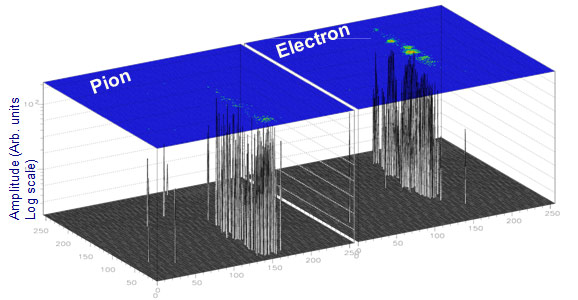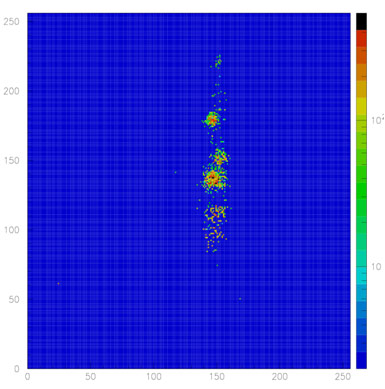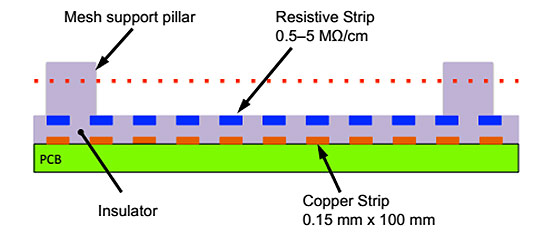New detectors development
One of the rapidly growing areas in the field of new elementary particles detectors is a development of Micro-Pattern detectors. MEPhI ATLAS group is actively involved in the development of so called gaseous pixel detectors (GasPixel). This technology uses the principle of MicroMegas cameras, where a pixel chip is used as a detecting element.
Fig. 1 illustrates the MicroMegas chambers operation principle. Particles traversing gas gap (drift gap) produce ionisation. Produced electrons drift towards the grid (Micromesh) and enter the region of high electric field (Amplification gap) where they are multiplied. The anode plane is split into the sensitive elements (strips or pixels depending on the camera setup). The use of pixel chips with a pixel size of 50-100 microns provides a possibility to have a detailed information about the particle track in the chamber. Fig. 2 shows pions and electrons tracks in the GasPixel chamber filled with xenon. Right panel shows an electron track in the pixel chip plane, where clusters of transition radiation photons absorbed in the chamber are clearly visible. Pixel color reflects the amplitude of the signal.

Fig. 2. Pions tracks (left) and electrons tracks (right) in the GasPixel chamber. Signal amplitude is also shown.

Fig. 3. Electron track in the GasPixel chamber. Signal amplitude is shown using different colors in the pixel chip plane.
Usage of gases with low diffusion (e.g. DME/CO2 50% / 50%) allows to achieve a record spatial resolution of gas detectors. Fig. 4 shows reconstruction accuracy of the particle intersection point with a chip plane. Timing information in each pixel provides an opportunity to reconstruct 3-dimensional position of the particle track. A potential advantage of this method is the ability to quickly (within a few microseconds) determine track parameters at the electronic chip level. This chip is placed directly on the detecting cell. This method allows to develop fast level 1 tracking trigger.
The MEPhI ATLAS group has recently joined the collaboration working on the modernization of the muon system, where new developments in the tracking detectors will be used. These detectors are based on the sTGC and MicroMegas technologies (fig. 5 and 6 respectively).
sTGC technology is a multiwire proportional chamber with a small drift gap (1.4 mm). Coordinate information is provided by readout of the signals from 3 mm strips of the cathode chamber.
МicroMegas technology uses modification which dramatically enhances the detector stability. In this technology the anode stripes, arranged at a pitch of 0.4 mm, are covered by resistive stripes (as shown in fig. 6). It completely eliminates any damage to the electronics in case of breakdown.
Publications:
- F. Hartjes, N. Hessey, M. Fransen, S. Konovalov, W. Koppert, S. Morozov, A. Romaniouk, V. Tikhomirov, H. Van der Graaf, Test beam studies of the GasPixel transition radiation detector prototype, Nucl. Instr. Meth, A706 (2013) 59
- А. Romaniouk, «A proposal for the GridPixel Tracker for the ATLAS sLHC upgrade», 1st International Conference on Micro Pattern Gaseous Detectors, 12-15 June, 2009. Kolympari, Crete, Greece
Contact Person:
Romaniouk Anatoli






